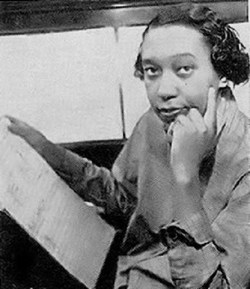In the course of the completely unsystematic way I find obscure works I've run across comparatively few composers from Minnesota, home of most of my extended family, aside from the wonderful Aaron Jay Kernis and the less wonderful Rolv Yttrehus. Carl Ruggles doesn't really count, as he was a New Englander for most of his life and only spent a handful of years in the state despite his vigorous efforts to turn a local orchestra into a new music powerhouse.
One Minnesotan that came to the fore in my research as quickly as I was unable to find any other pieces of theirs was Clara Stocker, a figure obscure enough that I wasn't able to find any pictures of her online (hence the condensed score header above). Born in Duluth and taught early on by her mother Stella, Stocker was a music critic to two different Duluth newspapers (the News Tribune and the Herald) and wrote program notes for the Duluth Symphony. She also taught French, and one of her most interesting studies was an attempt to teach phonetics using musical notation, or tonetics, and wrote papers on French Tonetics in the 20's which are available through Internet Archive (and more completely in JStor if you've got a institutional registration). She was also deeply interested in Finnish culture and art, maintaining a friendship with the painter Juho Rissanen and writing a number of works based on Finnish music and legends (including the only other piece of hers to be published, a set of Finnish folk song arrangements for recorders).
The only piece of hers I've seen in print (aside from those recorder pieces) is the Two Little Pieces for piano, published in 1937 by the seminal periodical New Music Edition (which has been previously featured here) along with two pieces by the Cuban composer Alejandro García Caturla. They were the result of the summer of 1936, spent studying with John J. Becker, a member of the American Five and someone I'll get to later (with one of my own performances to boot). Becker was a pioneer of free dissonance and an important, if now forgotten, figure in the birth of modernist music in America, and Stocker's work here reflects his influence in its use of dissonant counterpoint.
(Click each for larger view)
Now, you'll probably see that the first of the two pieces is technically longer than a page, and that's fine, because I'm more fond of the second, and I never said that pieces shorter than a page weren't admissable (and we'll be seeing more of those soon enough *COUGH* Howard Skempton *COUGH*). Both pieces are acidic contrapuntal whirls, fascinating little artifacts from a time when American music could have gone in any direction and not just the most academically provable and financially viable ones. The first piece, Vivace, is too hard for me to make a recording quickly, and sounds best played as fast as possible to cover up wrinkles in the counterpoint. The second piece, Moderato poco scherzando is an enchanting duet, like a pair of songbirds separated by mountain peaks. Both of them are best played with sparse pedalling and a keen ear for harmonic flexibility, and I wonder how many other of her works are written in this style. I've made a YouTube performance of the second one so you can judge for yourself how successful her tutelage under Becker was; I choose to think it worked out just fine.
~PNK







